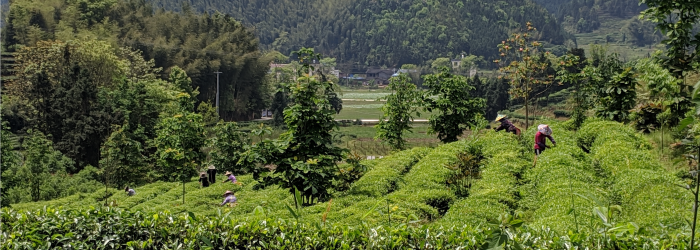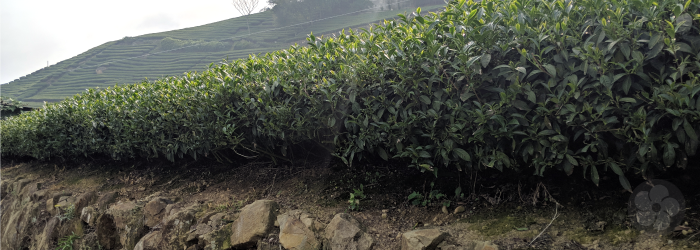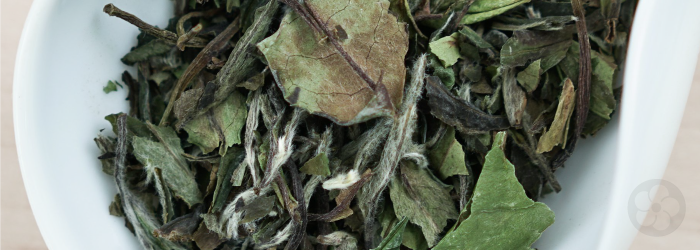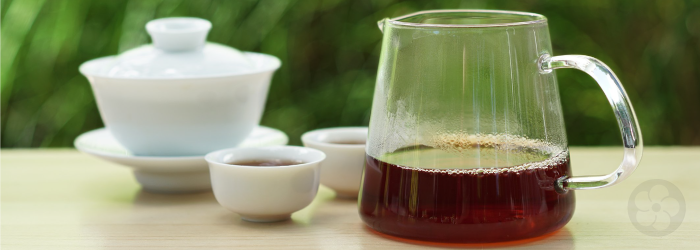Understanding Tea Identity: 5 Teas Defined by Provenance

Of the four main aspects of tea identity, provenance might be the most complex. Encompassing a variety of elements, from climate and weather patterns to the chemical composition of the soil, provenance (or terroir) helps define the flavor of every tea. Along with variety, harvest date, and craftsmanship, the area where a tea is grown can tell us a lot about what to expect when we brew a cup.
Learn more about the impact of harvest date by tasting these four teas >>
But it can sometimes be difficult to distinguish the effects of provenance, as traditional regions typically use specific varieties and crafting methods, as well. Many famous styles of Chinese tea have a worldwide reputation for the characteristics imparted by these environmental factors, but are now crafted in other regions to match demand from a growing market. Get familiar with the role of provenance in shaping tea flavor by tasting these five teas that just wouldn’t be the same if they were grown anywhere else.
1. Ming Qian Dragonwell Pan’an, Supreme
The world famous Dragonwell crafting style, made by pressing tea leaves into a hot wok to flatten them as they’re roasted, is most commonly associated with the city of Hangzhou, where it is a common daily brew, or with the picturesque area of nearby West Lake, where the style is said to have originated. While this region is easily accessible for tourists eager to see tea farms and pick their own leaves, we prefer to source our Dragonwells from Pan’an County, which lies just to the south, away from the densely populated metropolitan area.
Find out more about the history of Dragonwell tea >>
With the advantage of some distance, as well as higher elevations, we find that tea farmers in Pan’an County are able to maintain traditional crafting standards, as well as avoid the influence of heavy pollution. The flavor of Dragonwell teas grown here is familiar, thanks to soil composition and a deep understanding of the historic crafting style passed down through local generations.
In addition, tea gardens in this region, like the one where our Supreme crop is grown, have a major advantage in terroir over their more accessible West Lake counterparts: elevation. While not generally discussed in the context of Dragonwell, elevation allows tea plants to grow more slowly, and thus develop more complex flavor. The end result in our Pan’an Supreme crop is an extremely traditional spring Dragonwell, with an incredibly rich finish not found among the coveted West Lake harvests.
2. Bai Mu Dan
We often compare white teas to champagne, because their provenance is so key to their flavor, but also so commonly disregarded in the face of overwhelming market demand. While the most prized Silver Needle white teas rely on an early spring harvest date to ensure a naturally sweet finish, the more common Bai Mu Dan is harvested slightly later, and consists of a mixture of buds and larger leaves. Though all white teas are best sourced from the traditional region of Fuding County, Fujian, the late spring harvest date of this popular style makes terroir even more key.
Fuding County, the historical home of white tea, is a relatively remote region in the north of Fujian, a province known for many different types of tea. On the coast and moderately mountainous, the weather here is fairly temperate, in comparison with areas further inland. This temperate weather helps keep growth rates gradual, ensuring complex flavor in the minimally processed teas that are grown here. Because a late spring harvest contains fewer natural carbohydrates and has a more robust flavor than early spring buds, slow growth is especially important to creating a tea without bitterness or astringency.
Learn why we always source white teas from Fuding County >>
Similar-looking white teas from other regions are now available across China and the world, often at lower prices that are attractive to those seeking a reliable daily drink. However, these usually hail from landlocked Yunnan or other inland provinces, and fail to live up to the flavor quality found in an authentic Bai Mu Dan like ours, even when they are grown from the same variety of Camellia sinensis and crafted with the same minimal techniques.

3. Da Yu Lin, Spring
Few styles of tea depend on terroir as much as Formosa oolongs. Despite the relatively small size of Taiwan, teas produced on this subtropical island present a full range of flavor profiles. The most popular style by far is lightly oxidized oolong tea, rolled into small, tight bundles and gently roasted to maintain natural floral and fruity aromas. Despite today’s proliferation of teas from other parts of Asia which imitate this style, teas from Taiwan stand apart in flavor quality and mouth feel thanks to rich volcanic soil, relatively temperate weather, and constant innovation in cultivars and crafting methods.
Find out more about the history of Taiwanese teas >>
Though they have many similarities, Taiwan’s many oolongs are often differentiated by precise distinctions in provenance, and named for the specific mountain peak they are grown on. In general, teas from taller mountains are more sought after, as steeper slopes result in slower growth and smaller crop yields. The regular cloud cover at high elevations allows for complex flavor to develop during the growth process, and promotes the storage of carbohydrates, lending high mountain teas a naturally creamy texture and finish.
The highest tea-producing peak is Da Yu Lin, a mountain within the Lishan range that rises to nearly 9,000 feet above sea level. The extreme elevation makes it difficult to grow tea at all here, with limited usable land and risks of frost well into the usual spring harvest season. In recent years, tea cultivation has become even more sparse in this area as the Taiwanese government reclaims land to prevent erosion. But the tangible difference in flavor quality keeps demand for this tea high - the rich, complex flavor of this tea carries hints of tangerine and sugarcane, with a buttery finish that lingers long after the last sip.
Read about the effects of elevation on tea flavor >>
4. Old Grove Shui Xian, 2013
In the northwest corner of Fujian, the unique soil of another mountain range defines the whole category of Wuyi oolong teas by imparting a distinct, mineral-rich flavor to teas grown in this area. The tall, rocky cliffs of this area are often invoked in descriptions, or with common nicknames like “rock oolong” or “cliff tea”. This tea, with its intense, whiskey-like finish, is no exception.
However, this aspect of flavor is not what makes our Old Grove Shui Xian remarkable. In fact, because the flavor imparted by mineral-rich soil is so ubiquitous in this region, differences between teas within this style are often attributed to the choice of Camellia sinensis variety, rather than terroir. Shui Xian, the cultivar used for this tea, is a relatively new addition to the lineup of famous Wuyi varieties, with a less prestigious lineage than many others.
Learn more about the definition and importance of tea cultivars >>
So it isn’t the general terroir of the region that defines this tea as something special, nor the cultivar, but rather a more specific aspect of provenance: the age of the tea trees themselves. While not often given as much thought, the surrounding vegetation and the way the plants are cultivated are another important part of terroir. As with more obvious pieces of the puzzle like elevation or soil quality, the old trees from which this tea is harvested contribute more complex natural flavor to the leaves, because less new growth is produced each year as the plant matures.
5. Keemun
The final tea on our list is better recognized as the original version of English Breakfast tea. The name is an outdated romanization of the county in Anhui where this tea is made, a region now known as Qimun. When tea began to catch on in Europe, this chopped-leaf style of black tea was developed by enterprising Chinese tea sellers as a good option for export, and it quickly became popular among British tea drinkers.
Find out why Chinese black teas are so different from Indian black teas >>
Once the British began to invest in tea production in India, they were quick to replicate their favorite style using native Assam varieties, which yielded larger crops and were cheaper to produce than the original version from Qimun. With a long ship journey and a pitcher of fresh milk between farm and cup, the more robust versions from India quickly became the new standard for English Breakfast teas.
But today, the advantages of sourcing this style from the original region are clear. The more temperate climate of Anhui allows the tea plant to go into dormancy for the winter, storing up nutrients and developing more complex flavor compounds to be released during the growing season. Less rainfall in the spring keeps flavors more intense, while less sun exposure means fewer bitter and astringent molecules in the finished leaf. The end result is a tea that tastes soothingly familiar and can stand up to additions like milk and sugar, but also holds its own without extras. With flavor like this, it’s easy to see why English Breakfast became one of the world’s most popular styles.
Do you know where your favorite teas come from? What does their place of origin contribute to the final flavor? Let us know what you think in the comments below!
Sign up for our newsletter to get blog updates in your inbox!








Comments on this post (0)